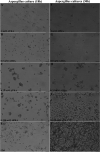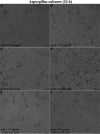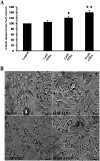Antifungal Effect of All- trans Retinoic Acid against Aspergillus fumigatus In Vitro and in a Pulmonary Aspergillosis In Vivo Model
- PMID: 33361288
- PMCID: PMC8092556
- DOI: 10.1128/AAC.01874-20
Antifungal Effect of All- trans Retinoic Acid against Aspergillus fumigatus In Vitro and in a Pulmonary Aspergillosis In Vivo Model
Abstract
Aspergillus fumigatus is the most common opportunistic fungal pathogen and causes invasive pulmonary aspergillosis (IPA), with high mortality among immunosuppressed patients. The fungistatic activity of all-trans retinoic acid (ATRA) has been recently described in vitro We evaluated the efficacy of ATRA in vivo and its potential synergistic interaction with other antifungal drugs. A rat model of IPA and in vitro experiments were performed to assess the efficacy of ATRA against Aspergillus in association with classical antifungal drugs and in silico studies used to clarify its mechanism of action. ATRA (0.5 and 1 mM) displayed a strong fungistatic activity in Aspergillus cultures, while at lower concentrations, synergistically potentiated fungistatic efficacy of subinhibitory concentration of amphotericin B (AmB) and posaconazole (POS). ATRA also enhanced macrophagic phagocytosis of conidia. In a rat model of IPA, ATRA reduced mortality similarly to posaconazole. Fungistatic efficacy of ATRA alone and synergistically with other antifungal drugs was documented in vitro, likely by inhibiting fungal heat shock protein 90 (Hsp90) expression and Hsp90-related genes. ATRA treatment reduced mortality in a model of IPA in vivo Those findings suggest ATRA as a suitable fungistatic agent that can also reduce dosage and adverse reactions of classical antifungal drugs and add to the development of new therapeutic strategies against IPA and systemic fungal infections.
Keywords: ATRA; Aspergillus; aspergillosis; invasive pulmonary aspergillosis; pneumonia; trans-retinoic acid.
Copyright © 2021 Campione et al.
Figures






References
-
- Samson RA, Visagie CM, Houbraken J, Hong S-B, Hubka V, Klaassen CHW, Perrone G, Seifert KA, Susca A, Tanney JB, Varga J, Kocsubé S, Szigeti G, Yaguchi T, Frisvad JC. 2014. Phylogeny, identification and nomenclature of the genus Aspergillus. Stud Mycol 78:141–173. doi:10.1016/j.simyco.2014.07.004. - DOI - PMC - PubMed
MeSH terms
Substances
LinkOut - more resources
Full Text Sources
Other Literature Sources

